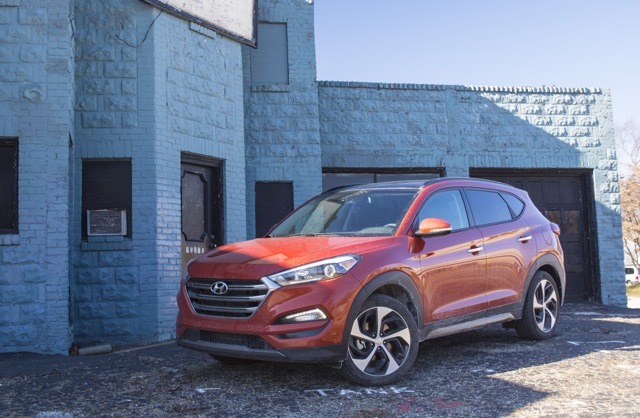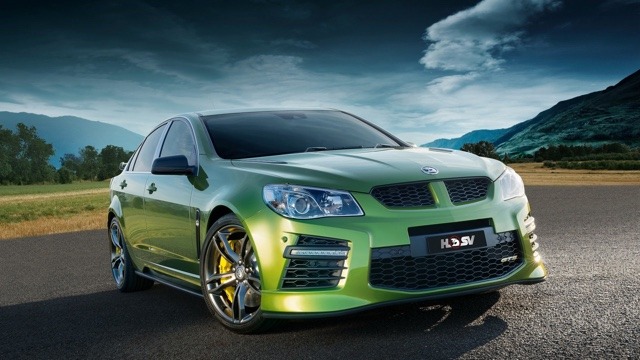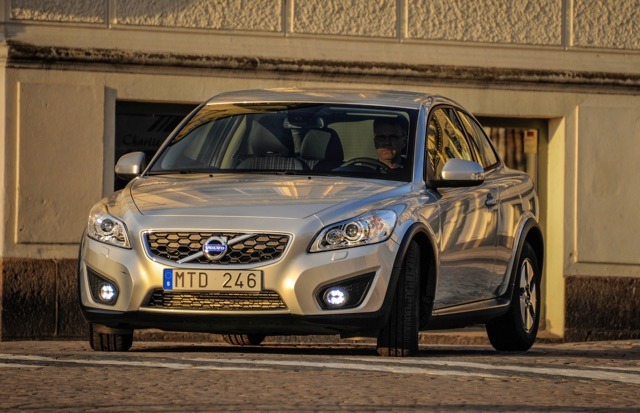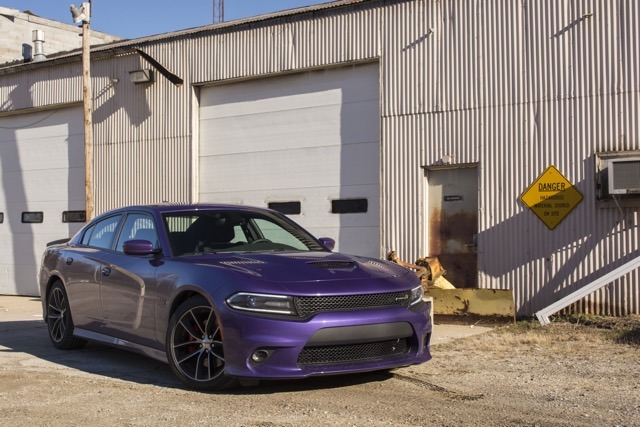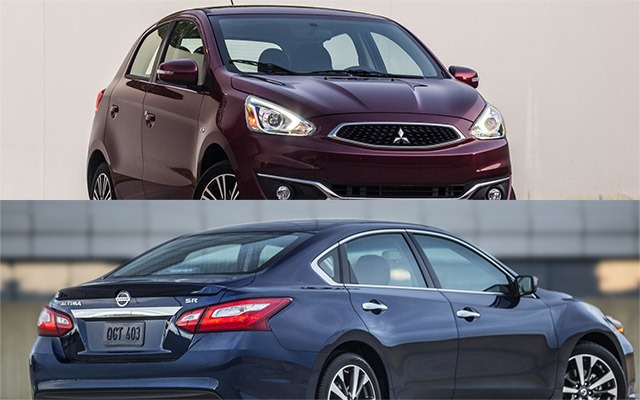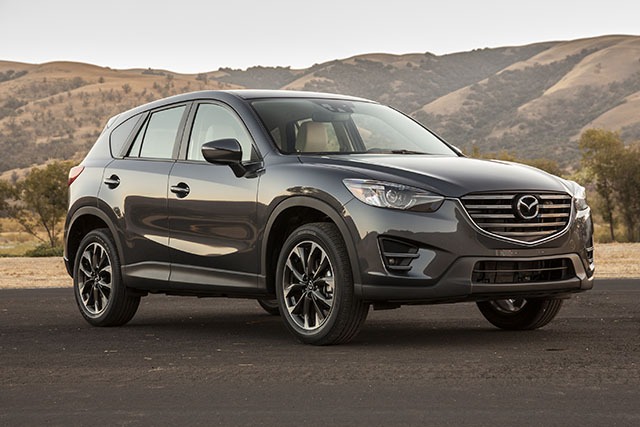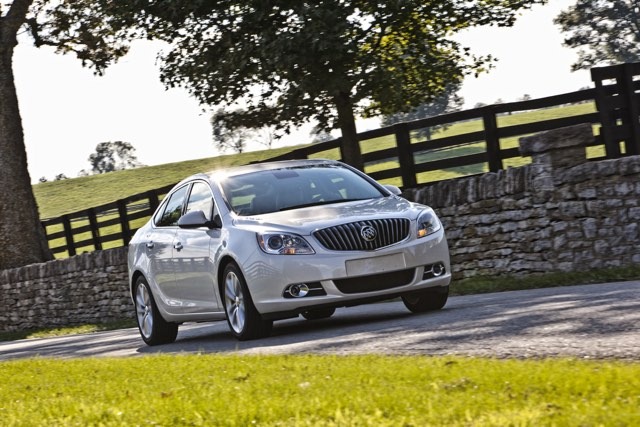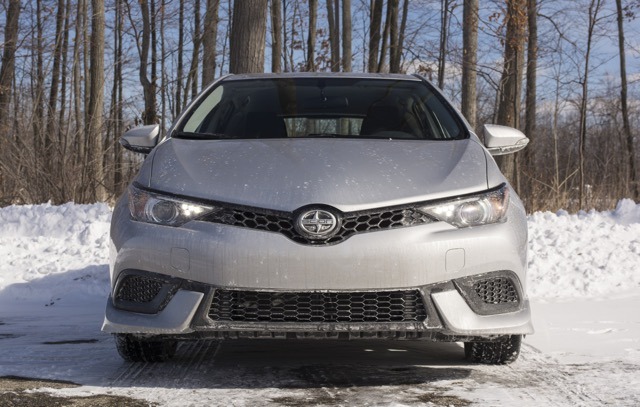-
Posts
32,884 -
Joined
-
Last visited
-
Days Won
5
Content Type
Forums
Articles
Garage
Gallery
Events
Store
Collections
Everything posted by William Maley
-
Small SUVs and crossovers are making huge gains in terms of sales. A key part of this success comes down to a single group of buyers, single women. Data from research company MaritzCX reveals that sales of small SUVs to women rose 34 percent between 2010 and 2015. In the same time, sales of these vehicles to single men only rose 22 percent. Sales of small luxury SUVs saw a large increase of 177 percent to women. Out of the total amount of women buyers, 40 percent are single. “There’s a group of single, professional females out there that need vehicles, and you need to be attentive to them,” said James Mulcrone, director of research services at MaritzCX to Bloomberg. “They’re going to make money, they’re going to make their own decisions, and they can be very loyal consumers.” Case in point, more than two-thirds of women buyers last year said their purchase was “entirely up to me.” Source: Bloomberg View full article
-

Small SUV Sales Are Climbing, Thanks In Part To Single Women
William Maley posted an article in Automotive Industry
Small SUVs and crossovers are making huge gains in terms of sales. A key part of this success comes down to a single group of buyers, single women. Data from research company MaritzCX reveals that sales of small SUVs to women rose 34 percent between 2010 and 2015. In the same time, sales of these vehicles to single men only rose 22 percent. Sales of small luxury SUVs saw a large increase of 177 percent to women. Out of the total amount of women buyers, 40 percent are single. “There’s a group of single, professional females out there that need vehicles, and you need to be attentive to them,” said James Mulcrone, director of research services at MaritzCX to Bloomberg. “They’re going to make money, they’re going to make their own decisions, and they can be very loyal consumers.” Case in point, more than two-thirds of women buyers last year said their purchase was “entirely up to me.” Source: Bloomberg -
The clocks tick down before the end of the rear-wheel drive Holden Commodore and Australian production. But Holden has plans to end it with a bang. News Corp Australia has learned that GM has given the go-ahead on Holden using the LS9 V8 from the last-generation Corvette ZR1 for special edition model. Producing 600 horsepower, this limited edition will be the fastest Commodore ever built. The sedan will only come with a six-speed manual as an automatic wouldn't be able to handle all of the power on tap. HSV will be tasked with building this fast Commodore. The total production amount is said to be less than 250 sedans. Holden declined to comment on this report. Source: news.com.au View full article
- 9 replies
-
- Commodore
- Corvette ZR1
-
(and 6 more)
Tagged with:
-

Rumorpile: Holden Plans A Big Bang for the End of the Commodore
William Maley posted an article in Holden
The clocks tick down before the end of the rear-wheel drive Holden Commodore and Australian production. But Holden has plans to end it with a bang. News Corp Australia has learned that GM has given the go-ahead on Holden using the LS9 V8 from the last-generation Corvette ZR1 for special edition model. Producing 600 horsepower, this limited edition will be the fastest Commodore ever built. The sedan will only come with a six-speed manual as an automatic wouldn't be able to handle all of the power on tap. HSV will be tasked with building this fast Commodore. The total production amount is said to be less than 250 sedans. Holden declined to comment on this report. Source: news.com.au- 9 comments
-
- Commodore
- Corvette ZR1
-
(and 6 more)
Tagged with:
-
If you were hoping for Volvo to do something smaller than the upcoming 40 Series (C30 hatchback), then you'll be disappointed with this news. Volvo CEO Hakan Samuelsson tells Car and Driver they're aren't planning to anything below the 40 Series. “It’s very hard to make money in that segment right now . . . of course we could downsize [our CMA architecture, which underpins the 40-series], but that is not on the agenda,” said Samuelsson. Volvo has played in this arena before with the C30 hatchback. But the model never really made an impact on the marketplace. Over the course of eight years, Volvo only sold around 200,000 C30s. Source: Car and Driver View full article
-
If you were hoping for Volvo to do something smaller than the upcoming 40 Series (C30 hatchback), then you'll be disappointed with this news. Volvo CEO Hakan Samuelsson tells Car and Driver they're aren't planning to anything below the 40 Series. “It’s very hard to make money in that segment right now . . . of course we could downsize [our CMA architecture, which underpins the 40-series], but that is not on the agenda,” said Samuelsson. Volvo has played in this arena before with the C30 hatchback. But the model never really made an impact on the marketplace. Over the course of eight years, Volvo only sold around 200,000 C30s. Source: Car and Driver
-

Dodge News: Rumorpile: It Will Be A Long Wait for the Next Charger
William Maley replied to William Maley's topic in Dodge
That's my suspicion -
The Dodge Charger is getting up there in age, not in looks but its platform. The 300 and Charger's LX platform uses suspension bits from older Mercedes-Benz models (W211 E-Class and W220 S-Class). According to Automotive News, there is a new Charger coming. But the bad news is that it will not be till after 2020. According to sources, the Charger will switch over to an extended version of the platform that underpins the Giulia - known as Giorgio. Overall length will remain around 198 inches, but weight is expected to drop about 500 pounds. There is talk about the turbocharged 2.0L four - codenamed Hurricane - being one of the engines on offer for the next-gen Charger. But why is FCA waiting till after 2020 to introduce the next Charger? The report doesn't say, but our guess would either be money or the number of delays for the Giulia have pushed back the timeline for other models using the platform. Either way, a source says the Charger will have a minor refresh in 2019. Source: Automotive News (Subscription Required) Pic Credit: William Maley for Cheers & Gears View full article
-
The Dodge Charger is getting up there in age, not in looks but its platform. The 300 and Charger's LX platform uses suspension bits from older Mercedes-Benz models (W211 E-Class and W220 S-Class). According to Automotive News, there is a new Charger coming. But the bad news is that it will not be till after 2020. According to sources, the Charger will switch over to an extended version of the platform that underpins the Giulia - known as Giorgio. Overall length will remain around 198 inches, but weight is expected to drop about 500 pounds. There is talk about the turbocharged 2.0L four - codenamed Hurricane - being one of the engines on offer for the next-gen Charger. But why is FCA waiting till after 2020 to introduce the next Charger? The report doesn't say, but our guess would either be money or the number of delays for the Giulia have pushed back the timeline for other models using the platform. Either way, a source says the Charger will have a minor refresh in 2019. Source: Automotive News (Subscription Required) Pic Credit: William Maley for Cheers & Gears
-
The past month at Mitsubishi Motors has been tumultuous with the announcement that they had manipulated fuel economy numbers on a number of small city cars sold by them and Nissan. It would come to light that this manipulation had been going since 1991 on a number of models sold in Japan. Shares in the company dropped like a rock and there were concerns that Mitsubishi Motors would have to borrow money from other companies in the Mitsubishi conglomerate. But soon a white knight would appear, Nissan. The company that first discovered and reported it to Mitsubishi would buy a 34 percent share into the automaker, making it the largest shareholder. Thus, an alliance between the two was created. The two automakers are currently still in the beginning stages of their alliance, but certain things have been made clear of what the two hope to accomplish. The biggest one is to improve the reputation of Mitsubishi Motors in Japan. There is also talk about two working together on electric vehicles and possibly sharing a platform for their next-generation pickups. One of the questions still up in the air is what will the alliance bring to the U.S.? That’s probably way down on the priority list for both companies. But it is something that will have to be discussed sooner or later. At the moment, there seem to be two camps of thought. The first is that Mitsubishi should make an exit out of the U.S. Sales are on the rise for the Japanese automaker, but they pale in comparison with other competitors. Also, Mitsubishi doesn’t have the presence as other automakers when it comes to getting the message out. The second is that Mitsubishi should stay, which for the most part is followed by ‘bring back the Lancer Evolution!’. I hate to be the evil person here, but it isn’t coming back. Stop asking for it. Recently I was going back through some old Autocar magazines and came across an editorial talking about Nissan’s change in strategy for the U.K. and how they are currently reaping the benefits. “I remember when Nissan said it was giving up the ‘boring’ car market and dealing only in what were, at the time, niches. Quirky tall things. Things that didn’t sell in large volumes. That funny Qashqai thing: not quite a car, not quite a 4x4 either. We weren’t long out of the 1990s, a decade in which the list of the top 10 best-selling cars in the UK went something like this: Ford's Fiesta, Focus, Mondeo, Vauxhall's Vectra, Astra, Corsa, Peugeot 306, Volkswagen Golf, Rovers 200, 400. Family cars all. Straight family cars. Not always a Nissan among them, although the Micra dabbled inside the top 10, because it was, then, a cute supermini. So Nissan got into what were seen as niches. Ballsy move. And it has stayed there.” It was quite the gamble when Nissan made this call in the 2000’s to drop out of some very popular segments at the time to focus on some odd vehicles. But it has paid off as Nissan has become one of the popular brands in the U.K. and two of their vehicles - the Qashqai and Juke - are in the top ten of the best-selling vehicles. This got me thinking, what if Mitsubishi and Nissan were to apply this same strategy for the U.S.? You might think I’m being somewhat crazy with this idea, but what does Mitsubishi have to lose? What could this strategy possibly look like? I think we need to go back to 2015 and look at comments made by Mitsubishi Motors CEO Osamu Masuko for a possible starting point. "We are strong in SUVs and four-wheel drives. And that is what we would like to focus on as core models in the U.S. market. We have changed direction. We are going to allocate more resources to the areas where we are strong in the U.S.” In 2015, more than 58 percent of Mitsubishi’s U.S. sales were crossovers. That trend is continuing in 2016 as 54 percent of sales through April are crossovers. We know that later this year, Mitsubishi will finally launch the long-delayed Outlander PHEV in the U.S. There is also talk of a small crossover and next-generation Montero/Pajero coming in the next few years. I know crossovers and SUVs aren’t really considered a niche anymore as every automaker has one. But this is an area that Mitsubishi that is quite strong. So what could Nissan bring to the table with crossovers/SUVs? A key item would be electrification. Yes, Mitsubishi does have a fair amount of experience here. But as I mentioned, one of the key things the two automakers are planning to work on together on electric vehicles. They could make some big inroads with building an electric crossover with decent range (200 or more miles). Considering the huge craving for crossovers by consumers, the two could strike something big here. The other item Nissan could bring is new a new platform and/or engines for the next-generation Outlander/Outlander Sport. One complaint about both crossovers are the four-cylinder engines as they don’t have enough power to get either model moving at a decent clip. There’s also the issue of Outlander Sport having a very jarring ride due to the suspension tuning. But this is one part of the Mitsubishi conundrum. The other deals with their other best-selling passenger car, the Mirage. Aside from being the current whipping boy of the automotive press, the Mirage makes up about 38.3 percent of Mitsubishi’s 2016 sales through April. A lot this is due to the low price of the model ($12,995). To capitalize on this success, Mitsubishi will be launching a Mirage sedan later this year. To go back to the comments made by Masuko, “We are strong in SUVs and four-wheel drives. And that is what we would like to focus on as core models in the U.S. Market.” But the Mirage is proving to be a strong model and one that should be considered a core model. It would be mad for Mitsubishi to drop it. One thing that the Mirage does need is a new engine. The 1.2L three-cylinder does deliver excellent fuel economy figures (37 City/43 Highway), but it is slow. Snails could outrun this vehicle. This is where Nissan could come in by giving the Mirage an engine transplant. The 1.6L four-cylinder from the Versa/Versa Note with 109 horsepower would provide a needed boost in power and wouldn’t affect fuel economy numbers much. Now that I have outlined some key issues and comments, let’s dive into what a smaller lineup for Mitsubishi could possibly look like with some help from Nissan. Mirage/Mirage G4: New engine from Nissan and possibly an improved interior. Lancer: Rebadged version of Sentra and Pulsar Hatchback, or Nissan helps with speeding up development of the next-gen model. Outlander Sport: Electric model possibly joins range. Outlander: Plug-in hybrid model sticks around. Pajero/Montero: All Mitsubishi here. Gas and plug-in hybrid powertrains on offer. Five and seven-seat configurations on offer. Triton/L200: Next-Generation model using Nissan Navara platform. Mitsubishi works on everything else from engines and four-wheel drive system. This is way out as both companies have introduced their latest trucks. Would Nissan be willing to help Mitsubishi with this? That is tough to say at this time since we’re still in the honeymoon period between the two automakers and there are more pressing things to address. There is also the consideration of why Nissan would help a competitor in the market. But Mitsubishi is a small bit player in the U.S. Last year, Mitsubishi only sold 95,342 vehicles. This pales in comparison with the 1,484,918 vehicles sold by Nissan last year. This could help Mitsubishi out with making a case for this idea. The U.S. is way down on the priority list between Mitsubishi and Nissan. But I’m sure the U.S. offices are thinking about what will happen. There are two real choices that are on the table, either leave the U.S. market or take a gamble and change up your lineup somewhat drastically. If I was Mitsubishi, I would push for the latter option by using the niche plan. View full article
- 3 replies
-
- Afterthoughts
- Alliance
-
(and 4 more)
Tagged with:
-
The past month at Mitsubishi Motors has been tumultuous with the announcement that they had manipulated fuel economy numbers on a number of small city cars sold by them and Nissan. It would come to light that this manipulation had been going since 1991 on a number of models sold in Japan. Shares in the company dropped like a rock and there were concerns that Mitsubishi Motors would have to borrow money from other companies in the Mitsubishi conglomerate. But soon a white knight would appear, Nissan. The company that first discovered and reported it to Mitsubishi would buy a 34 percent share into the automaker, making it the largest shareholder. Thus, an alliance between the two was created. The two automakers are currently still in the beginning stages of their alliance, but certain things have been made clear of what the two hope to accomplish. The biggest one is to improve the reputation of Mitsubishi Motors in Japan. There is also talk about two working together on electric vehicles and possibly sharing a platform for their next-generation pickups. One of the questions still up in the air is what will the alliance bring to the U.S.? That’s probably way down on the priority list for both companies. But it is something that will have to be discussed sooner or later. At the moment, there seem to be two camps of thought. The first is that Mitsubishi should make an exit out of the U.S. Sales are on the rise for the Japanese automaker, but they pale in comparison with other competitors. Also, Mitsubishi doesn’t have the presence as other automakers when it comes to getting the message out. The second is that Mitsubishi should stay, which for the most part is followed by ‘bring back the Lancer Evolution!’. I hate to be the evil person here, but it isn’t coming back. Stop asking for it. Recently I was going back through some old Autocar magazines and came across an editorial talking about Nissan’s change in strategy for the U.K. and how they are currently reaping the benefits. “I remember when Nissan said it was giving up the ‘boring’ car market and dealing only in what were, at the time, niches. Quirky tall things. Things that didn’t sell in large volumes. That funny Qashqai thing: not quite a car, not quite a 4x4 either. We weren’t long out of the 1990s, a decade in which the list of the top 10 best-selling cars in the UK went something like this: Ford's Fiesta, Focus, Mondeo, Vauxhall's Vectra, Astra, Corsa, Peugeot 306, Volkswagen Golf, Rovers 200, 400. Family cars all. Straight family cars. Not always a Nissan among them, although the Micra dabbled inside the top 10, because it was, then, a cute supermini. So Nissan got into what were seen as niches. Ballsy move. And it has stayed there.” It was quite the gamble when Nissan made this call in the 2000’s to drop out of some very popular segments at the time to focus on some odd vehicles. But it has paid off as Nissan has become one of the popular brands in the U.K. and two of their vehicles - the Qashqai and Juke - are in the top ten of the best-selling vehicles. This got me thinking, what if Mitsubishi and Nissan were to apply this same strategy for the U.S.? You might think I’m being somewhat crazy with this idea, but what does Mitsubishi have to lose? What could this strategy possibly look like? I think we need to go back to 2015 and look at comments made by Mitsubishi Motors CEO Osamu Masuko for a possible starting point. "We are strong in SUVs and four-wheel drives. And that is what we would like to focus on as core models in the U.S. market. We have changed direction. We are going to allocate more resources to the areas where we are strong in the U.S.” In 2015, more than 58 percent of Mitsubishi’s U.S. sales were crossovers. That trend is continuing in 2016 as 54 percent of sales through April are crossovers. We know that later this year, Mitsubishi will finally launch the long-delayed Outlander PHEV in the U.S. There is also talk of a small crossover and next-generation Montero/Pajero coming in the next few years. I know crossovers and SUVs aren’t really considered a niche anymore as every automaker has one. But this is an area that Mitsubishi that is quite strong. So what could Nissan bring to the table with crossovers/SUVs? A key item would be electrification. Yes, Mitsubishi does have a fair amount of experience here. But as I mentioned, one of the key things the two automakers are planning to work on together on electric vehicles. They could make some big inroads with building an electric crossover with decent range (200 or more miles). Considering the huge craving for crossovers by consumers, the two could strike something big here. The other item Nissan could bring is new a new platform and/or engines for the next-generation Outlander/Outlander Sport. One complaint about both crossovers are the four-cylinder engines as they don’t have enough power to get either model moving at a decent clip. There’s also the issue of Outlander Sport having a very jarring ride due to the suspension tuning. But this is one part of the Mitsubishi conundrum. The other deals with their other best-selling passenger car, the Mirage. Aside from being the current whipping boy of the automotive press, the Mirage makes up about 38.3 percent of Mitsubishi’s 2016 sales through April. A lot this is due to the low price of the model ($12,995). To capitalize on this success, Mitsubishi will be launching a Mirage sedan later this year. To go back to the comments made by Masuko, “We are strong in SUVs and four-wheel drives. And that is what we would like to focus on as core models in the U.S. Market.” But the Mirage is proving to be a strong model and one that should be considered a core model. It would be mad for Mitsubishi to drop it. One thing that the Mirage does need is a new engine. The 1.2L three-cylinder does deliver excellent fuel economy figures (37 City/43 Highway), but it is slow. Snails could outrun this vehicle. This is where Nissan could come in by giving the Mirage an engine transplant. The 1.6L four-cylinder from the Versa/Versa Note with 109 horsepower would provide a needed boost in power and wouldn’t affect fuel economy numbers much. Now that I have outlined some key issues and comments, let’s dive into what a smaller lineup for Mitsubishi could possibly look like with some help from Nissan. Mirage/Mirage G4: New engine from Nissan and possibly an improved interior. Lancer: Rebadged version of Sentra and Pulsar Hatchback, or Nissan helps with speeding up development of the next-gen model. Outlander Sport: Electric model possibly joins range. Outlander: Plug-in hybrid model sticks around. Pajero/Montero: All Mitsubishi here. Gas and plug-in hybrid powertrains on offer. Five and seven-seat configurations on offer. Triton/L200: Next-Generation model using Nissan Navara platform. Mitsubishi works on everything else from engines and four-wheel drive system. This is way out as both companies have introduced their latest trucks. Would Nissan be willing to help Mitsubishi with this? That is tough to say at this time since we’re still in the honeymoon period between the two automakers and there are more pressing things to address. There is also the consideration of why Nissan would help a competitor in the market. But Mitsubishi is a small bit player in the U.S. Last year, Mitsubishi only sold 95,342 vehicles. This pales in comparison with the 1,484,918 vehicles sold by Nissan last year. This could help Mitsubishi out with making a case for this idea. The U.S. is way down on the priority list between Mitsubishi and Nissan. But I’m sure the U.S. offices are thinking about what will happen. There are two real choices that are on the table, either leave the U.S. market or take a gamble and change up your lineup somewhat drastically. If I was Mitsubishi, I would push for the latter option by using the niche plan.
- 3 comments
-
- Afterthoughts
- Alliance
-
(and 4 more)
Tagged with:
-
Mazda's diesel engine for the U.S. is slowly becoming an urban legend in the automotive world. Originally planned to launch in 2013, numerous delays have caused people to wonder if this engine would ever come out. Now with the Volkswagen diesel scandal hanging over and causing a number of automakers to reconsider diesel vehicles for the U.S., Mazda says its still committed. Speaking with Automotive News, Mazda's senior vice president for U.S. operations Robert Davis said diesel is still on the table. Diesel would not only boost the impressive fuel-economy numbers that Mazda's current lineup gets, it would also differentiate them from other Japanese rivals and align it more with European brands. Davis said the company is considering a diesel option for two of its vehicle, but wouldn't say which - our money is on the Mazda6 and CX-5 - or when they might come out. "I don't speak timing because I made three commitments and missed all three, so I keep my mouth shut. We're still committed to it," said Davis. Source: Automotive News (Subscription Required)
-
Mazda's diesel engine for the U.S. is slowly becoming an urban legend in the automotive world. Originally planned to launch in 2013, numerous delays have caused people to wonder if this engine would ever come out. Now with the Volkswagen diesel scandal hanging over and causing a number of automakers to reconsider diesel vehicles for the U.S., Mazda says its still committed. Speaking with Automotive News, Mazda's senior vice president for U.S. operations Robert Davis said diesel is still on the table. Diesel would not only boost the impressive fuel-economy numbers that Mazda's current lineup gets, it would also differentiate them from other Japanese rivals and align it more with European brands. Davis said the company is considering a diesel option for two of its vehicle, but wouldn't say which - our money is on the Mazda6 and CX-5 - or when they might come out. "I don't speak timing because I made three commitments and missed all three, so I keep my mouth shut. We're still committed to it," said Davis. Source: Automotive News (Subscription Required) View full article
-

Buick News: Buick Makes it Official, Verano Disappears in 2017
William Maley posted a topic in Buick
Earlier this month, we reported that the Buick Verano would be leaving at the end of the 2017 model year. This is due to the sales sliding down due in part to the success of crossovers such as the Encore. At the time, General Motors declined to comment on the story. Today, they have made it official. In a statement provided to Automotive News, General Motors said Verano production would wind down at its Lake Orion plant in October. The model will have an abbreviated 2017 model year. The decision as to why comes down to crossovers. “When we’re thinking about where we’re investing for the future, with the whole market moving toward SUVs, that’s where we want to put our investment,” said Buick spokesman Stuart Fowle to The Detroit News. Workers at Lake Orion were notified about the decision on Wednesday. Dealers were told about it during national meetings in Austin, Texas this week. The writing on the wall for the Verano's departure has been on the wall for a while. Last year, Buick sold 31,886 Veranos while the similarly priced Encore crossover moved 67,549 units. Also, Buick's chief Duncan Aldred said that 70 percent of Buick's sales will be made up of crossovers once the Envision hits dealers. Source: Automotive News (Subscription Required), The Detroit News View full article- 54 replies
-
- Buick
- Buick Verano
-
(and 3 more)
Tagged with:
-
Earlier this month, we reported that the Buick Verano would be leaving at the end of the 2017 model year. This is due to the sales sliding down due in part to the success of crossovers such as the Encore. At the time, General Motors declined to comment on the story. Today, they have made it official. In a statement provided to Automotive News, General Motors said Verano production would wind down at its Lake Orion plant in October. The model will have an abbreviated 2017 model year. The decision as to why comes down to crossovers. “When we’re thinking about where we’re investing for the future, with the whole market moving toward SUVs, that’s where we want to put our investment,” said Buick spokesman Stuart Fowle to The Detroit News. Workers at Lake Orion were notified about the decision on Wednesday. Dealers were told about it during national meetings in Austin, Texas this week. The writing on the wall for the Verano's departure has been on the wall for a while. Last year, Buick sold 31,886 Veranos while the similarly priced Encore crossover moved 67,549 units. Also, Buick's chief Duncan Aldred said that 70 percent of Buick's sales will be made up of crossovers once the Envision hits dealers. Source: Automotive News (Subscription Required), The Detroit News
- 54 comments
-
- Buick
- Buick Verano
-
(and 3 more)
Tagged with:
-
A few days before I got the 2016 Scion iM to do a week-long evaluation, news came out that Toyota would be closing the brand this fall. Most of the lineup, including the iM, would move over to Toyota. It feels somewhat weird to do a review on a brand that is essentially a dead man walking. But with the iM moving to the Corolla family, it would give us an idea of whether or not we recommend it. The Scion iM is a rebadged Toyota Auris that is sold in Europe and Japan. There isn’t a lot of differences between two models aside from new mesh inserts for the front and 17-inch alloy wheels. The overall design is polarizing. The front is long and low, with a narrow grille and bumper that looks like it has fangs. Around back is an interesting shape for the tailgate. Moving inside, the roots of Corolla show up. For example, the iM’s dashboard and certain equipment such as the steering wheel come from the Corolla. Many of the materials are hard plastics, while the door panels have some fabric covering certain parts. Considering the price tag of the iM, this isn’t a big deal. Scion should be given some credit for making the iM’s interior have some style such as a strip of faux leather running along the glove box and contrast stitching on the seats. In terms of comfort, the iM is mixed. On short trips, the front seats provide decent support. Longer trips reveals the lack of thigh support. The back seat is small with limited head and legroom. Cargo space is towards the small side with only 20.8 cubic feet, trailing the Volkswagen Golf (22.8 cubic feet) and Ford Focus hatchback (23.3 cubic feet). Standard on the iM is a seven-inch touchscreen radio. It is your standard Toyota touchscreen system with a simple, if somewhat dated interface. The system is quick to respond when going between the various functions. Navigation is available as an option. Power for the iM comes from the Corolla LE Eco, a 1.8L four-cylinder producing 137 horsepower and 126 pound-feet of torque. This can either be paired with either a six-speed manual or a CVT like our tester. Power delivery is not impressive as the engine can’t keep up with traffic and produces more sound than speed. Your foot will be near the floor if you want to try and get up to speed at a somewhat decent rate. The CVT seems to mesh with the engine better than the six-speed manual we drove last year. It is smart to know when it needs to increase or decrease engine rpm for various driving situations. In terms of fuel economy, the iM equipped with a CVT is rated at 28 City/37 Highway/32 Combined. We didn’t get close to any of those numbers as we only recorded 25.3 MPG for the week. A lot of this can be attributed to the iM coming during one of the coldest weeks in Detroit where temperatures were between -10’ to 20’ Fahrenheit. Before I would go anywhere, I would start up the vehicle to let it warm up for a few moments. If it was a bit warmer, I wouldn’t be surprised I could get the EPA numbers. One item I couldn’t fully report on during the iM first drive was how it rode. The particular vehicle I drove was fitted with some TRD suspension parts, giving me some different impressions from other folks that drove the standard model Now I can report on the iM’s ride and say it is pretty good. The iM provides a very forgiving ride on rough surfaces. This is partly due to the iM using an independent rear suspension and not the solid-axle setup found in the Corolla. We do wish Scion had put some sound deadening material in the iM as road noise comes in clear. Around corners, the iM doesn’t embarrass itself. There is little body roll and it feels composed. Steering is the weak point as it has rubbery feeling. The one place where Scion iM comes out on top is price. The 2016 iM starts at $19,255 for the manual and $19,995 for the CVT. Our tester with a few accessories came to an as-tested price of $20,334. That includes the touchscreen radio, dual-zone climate control, alloy wheels, LED taillights, keyless entry, and a backup camera. No other car in the class comes close. At the moment, we wouldn’t recommend the Scion iM. The engine is the big weakness as it can’t keep up with traffic and produces more sound than actual power. We also wished there was a little bit more cargo room. The low price does make it tempting, but a slightly used compact would be a better choice. As Scion drives off into the sunset and the iM heads over to Toyota, the automaker has its work cut out. There is a good car in the iM, but it needs a fair amount of changes. Whether Toyota does them or not remains to be seen. Cheers: Price, Ride Quality, Out There Styling Jeers: Lethargic Engine, Steering, Interior Space Disclaimer: Scion Provided the iM, Insurance, and One Tank of Gas Year: 2016 Make: Scion Model: iM Trim: N/A Engine: 1.8L DOHC 16-Valve, Valvematic Four-Cylinder Driveline: Front-Wheel Drive, CVT Horsepower @ RPM: 137 @ 6,100 Torque @ RPM: 126 @ 4,000 Fuel Economy: City/Highway/Combined - 28/37/32 Curb Weight: 3,031 lbs Location of Manufacture: Base Price: $19,200 As Tested Price: $20,334 (Includes $795.00 Destination Charge) Options: Carpeted Floormats and Cargo Mat - $185.00 Rear Bumper Protector - $89.00 Wheel Locks - $65.00 View full article
-
A few days before I got the 2016 Scion iM to do a week-long evaluation, news came out that Toyota would be closing the brand this fall. Most of the lineup, including the iM, would move over to Toyota. It feels somewhat weird to do a review on a brand that is essentially a dead man walking. But with the iM moving to the Corolla family, it would give us an idea of whether or not we recommend it. The Scion iM is a rebadged Toyota Auris that is sold in Europe and Japan. There isn’t a lot of differences between two models aside from new mesh inserts for the front and 17-inch alloy wheels. The overall design is polarizing. The front is long and low, with a narrow grille and bumper that looks like it has fangs. Around back is an interesting shape for the tailgate. Moving inside, the roots of Corolla show up. For example, the iM’s dashboard and certain equipment such as the steering wheel come from the Corolla. Many of the materials are hard plastics, while the door panels have some fabric covering certain parts. Considering the price tag of the iM, this isn’t a big deal. Scion should be given some credit for making the iM’s interior have some style such as a strip of faux leather running along the glove box and contrast stitching on the seats. In terms of comfort, the iM is mixed. On short trips, the front seats provide decent support. Longer trips reveals the lack of thigh support. The back seat is small with limited head and legroom. Cargo space is towards the small side with only 20.8 cubic feet, trailing the Volkswagen Golf (22.8 cubic feet) and Ford Focus hatchback (23.3 cubic feet). Standard on the iM is a seven-inch touchscreen radio. It is your standard Toyota touchscreen system with a simple, if somewhat dated interface. The system is quick to respond when going between the various functions. Navigation is available as an option. Power for the iM comes from the Corolla LE Eco, a 1.8L four-cylinder producing 137 horsepower and 126 pound-feet of torque. This can either be paired with either a six-speed manual or a CVT like our tester. Power delivery is not impressive as the engine can’t keep up with traffic and produces more sound than speed. Your foot will be near the floor if you want to try and get up to speed at a somewhat decent rate. The CVT seems to mesh with the engine better than the six-speed manual we drove last year. It is smart to know when it needs to increase or decrease engine rpm for various driving situations. In terms of fuel economy, the iM equipped with a CVT is rated at 28 City/37 Highway/32 Combined. We didn’t get close to any of those numbers as we only recorded 25.3 MPG for the week. A lot of this can be attributed to the iM coming during one of the coldest weeks in Detroit where temperatures were between -10’ to 20’ Fahrenheit. Before I would go anywhere, I would start up the vehicle to let it warm up for a few moments. If it was a bit warmer, I wouldn’t be surprised I could get the EPA numbers. One item I couldn’t fully report on during the iM first drive was how it rode. The particular vehicle I drove was fitted with some TRD suspension parts, giving me some different impressions from other folks that drove the standard model Now I can report on the iM’s ride and say it is pretty good. The iM provides a very forgiving ride on rough surfaces. This is partly due to the iM using an independent rear suspension and not the solid-axle setup found in the Corolla. We do wish Scion had put some sound deadening material in the iM as road noise comes in clear. Around corners, the iM doesn’t embarrass itself. There is little body roll and it feels composed. Steering is the weak point as it has rubbery feeling. The one place where Scion iM comes out on top is price. The 2016 iM starts at $19,255 for the manual and $19,995 for the CVT. Our tester with a few accessories came to an as-tested price of $20,334. That includes the touchscreen radio, dual-zone climate control, alloy wheels, LED taillights, keyless entry, and a backup camera. No other car in the class comes close. At the moment, we wouldn’t recommend the Scion iM. The engine is the big weakness as it can’t keep up with traffic and produces more sound than actual power. We also wished there was a little bit more cargo room. The low price does make it tempting, but a slightly used compact would be a better choice. As Scion drives off into the sunset and the iM heads over to Toyota, the automaker has its work cut out. There is a good car in the iM, but it needs a fair amount of changes. Whether Toyota does them or not remains to be seen. Cheers: Price, Ride Quality, Out There Styling Jeers: Lethargic Engine, Steering, Interior Space Disclaimer: Scion Provided the iM, Insurance, and One Tank of Gas Year: 2016 Make: Scion Model: iM Trim: N/A Engine: 1.8L DOHC 16-Valve, Valvematic Four-Cylinder Driveline: Front-Wheel Drive, CVT Horsepower @ RPM: 137 @ 6,100 Torque @ RPM: 126 @ 4,000 Fuel Economy: City/Highway/Combined - 28/37/32 Curb Weight: 3,031 lbs Location of Manufacture: Base Price: $19,200 As Tested Price: $20,334 (Includes $795.00 Destination Charge) Options: Carpeted Floormats and Cargo Mat - $185.00 Rear Bumper Protector - $89.00 Wheel Locks - $65.00
-
Very few engines have a long history of powering various vehicles - the small-block Chevrolet V8 and the Buick 3.5L V8 that would be used in a number of British vehicles. Another one can be found under the hood of the Bentley Mulsanne, the 6.75L (6 and 3/4 in Bentley parlance) twin-turbo V8 can trace its roots back to 1959. But the final curtain call for this engine is coming. Bentley CEO Wolfgang Dürheimer told Car and Driver that the V8 has found its “final home” in the Mulsanne. The next-generation Bentley flagship would switch to a 12-Cylinder (most likely a W12 one). Keep in mind this isn't likely going to happen until the next decade as the Mulsanne recently underwent a refresh. This isn't the first time the V8 - known as the L-Series - has been shown the door. Back when BMW owned Bentley in the mid-nineties, the automaker dropped the L-Series V8 and replaced it with one of their own with the new Arnage. Volkswagen would snap Bentley up in 1998 and would bring back the L-Series for the Arnage in the Red Label. The BMW V8 would stick around in the Arnage Green Label. However due to poor sales of the Green Label, Bentley dropped it - engine and all. Source: Car and Driver View full article
- 10 replies
-
- 6.75L Twin-Turbo V8
- Bentley
-
(and 3 more)
Tagged with:
-
From the album: Review: 2016 Scion iM
-
From the album: Review: 2016 Scion iM
-
From the album: Review: 2016 Scion iM
-
From the album: Review: 2016 Scion iM
-
From the album: Review: 2016 Scion iM
-
From the album: Review: 2016 Scion iM



